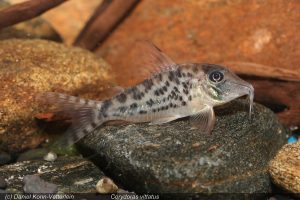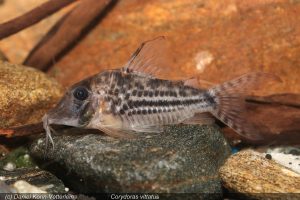From a tributary of the Rio Itapicuru (Maranhão, northeastern Brazil) comes Corydoras vittatus NIJSSEN 1971, an often-overlooked Corydoras, of which one reads and hears far too seldom. Although described as early as 1971, C. vittatus has not been a valid species for that long. Until 2001 it was considered a subspecies of Corydoras blochi, and it was not until 28 years after its scientific description that the subspecies was finally elevated to species status (ISBRÜCKER 1999b), and later confirmed as such (ISBRÜCKER 2001).
 |
 |
The species name translates to “adorned with a band” and is a reference to the conspicuous markings of the species: the dark bandage, which gives the species its name, runs across the head from gill cover to gill cover and also completely encloses the eyes. In exceptional cases, this band extends over the entire snout area and thus colours half the head in dark black. The body can be differently marked and coloured. Laterally three dark, partly interrupted longitudinal lines stand out, which are sometimes more and sometimes less distinct in their expression. The middle one is mostly continuous and most clearly visible. The upper as well as the lower one is only dashed coherent.
A dark tail root patch is always present but varies in intensity from individual to individual. Dorsal and caudal fin are regularly dark spotted. On the holotype (ZMA 109.990) only the middle line is well visible, the other two as well as the caudal spot are faded. The variability of the species can already be guessed from the specimens shown here. The younger specimen shows an irregular blotch rather than the mentioned three lateral lines, which are only visible at second glance. C. vittatus reaches a total length of about 7 cm in the aquarium, whereby females become somewhat larger than males. One reads very little about successful reproduction, there seems to be a need to catch up here.
BARRIGA (2012) lists the species for Ecuador and states that it is found in the Río Napo and Río Pastaza drainage. Considering that between this region and the type locality of the species lie large parts of Amazonia with numerous ecological barriers, it is more likely that the armoured catfish from Ecuador is a different species.
My thanks go to Haakon HAAGENSEN (Midtun Zoo Center, Bergen, Norway) who drew my attention to the species in his tank and willingly made his photo tank available for an afternoon.
Text and pictrues: Daniel KONN-VETTERLEIN
Literature:
- BARRIGA, B. 2012. Lista de Peces de Agua dulce e Intermareales del Ecuador*. Politécnica 30 (3): 83-119.
- ISBRÜCKER, I. J. H. 1999b. Corydoras geoffroy und Cataphractus punctatus. Revision der beien zuerst entdeckten Arten der Unterfamilie Corydoradinae (Actinopterygii, Siluriformes, Callichthyidae), Schluß.- Die Aquarien- und Terrarienzeitschrift (DATZ Aquarien Terrarien), 52 (8): 38-43.
- ISBRÜCKER, I. J. H. 2001. Catalogue of genera and species of Corydoradinae Hoedeman, 1952 (Teleostei, Ostariophysi, Callichthyidae), including citation of type localities, type specimens, and etymologies. Pp. 213-247 in I. A. M. Fuller, Breeding corydoradine catfishes. Ian Fuller Enterprises, Kidderminster, 248 pp.
- NIJSSEN, H. 1971. Two new species and one new subspecies of the South American catfish genus Corydoras (Pisces, Siluriformes, Callichthyidae). Beaufortia v. 19 (No. 250): 89-98.